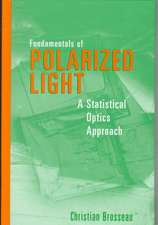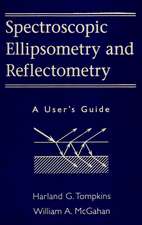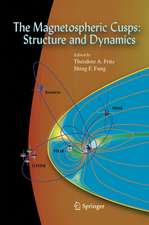A Practical Guide to Experimental Geometrical Optics
Autor Yuriy A. Garbovskiy, Anatoliy V. Glushchenkoen Limba Engleză Hardback – 27 dec 2017
Preț: 376.71 lei
Nou
Puncte Express: 565
Preț estimativ în valută:
72.08€ • 78.62$ • 60.78£
72.08€ • 78.62$ • 60.78£
Carte disponibilă
Livrare economică 03-17 aprilie
Preluare comenzi: 021 569.72.76
Specificații
ISBN-13: 9781107170940
ISBN-10: 110717094X
Pagini: 238
Ilustrații: 146 b/w illus. 97 tables
Dimensiuni: 178 x 253 x 15 mm
Greutate: 0.63 kg
Editura: Cambridge University Press
Colecția Cambridge University Press
Locul publicării:New York, United States
ISBN-10: 110717094X
Pagini: 238
Ilustrații: 146 b/w illus. 97 tables
Dimensiuni: 178 x 253 x 15 mm
Greutate: 0.63 kg
Editura: Cambridge University Press
Colecția Cambridge University Press
Locul publicării:New York, United States
Cuprins
Preface; 1. Markets of optical materials, components, accessories, light sources and detectors; 2. Introduction to optical experiments: light producing, light managing, light detection and measuring; 3. Light detectors based on semiconductors: photoresistors, photodiodes in a photo-galvanic regime. Principles of operation and measurements; 4. Linear light detectors based on photodiodes; 5. Basic laws of geometrical optics: experimental verification; 6. Converging and diverging thin lenses; 7. Thick lenses; 8. Lens systems; 9. Simple optical instruments I: the eye and the magnifier, eyepieces and telescopes; 10. Simple optical instruments II: light illuminators and microscope; 11. Spherical mirrors; 12. Introduction to optical aberrations; 13. Elements of optical radiometry; 14. Cylindrical lenses and vials; 15. Methods of geometrical optics to measure refractive index; 16. Dispersion of light and prism spectroscope; 17. Elements of computer aided optical design; Index.
Recenzii
'This book is unique in that it fills the gap between theory textbooks and laboratory manuals in the field of optics. [The authors] provide descriptions of experiments supported by theoretical explanations of the phenomena responsible … The text can also be used by instructors looking for a laboratory manual or by optical scientists hoping to hone their experimental skills. It offers valuable advice to those looking to build an optics lab, including guidance on what equipment to purchase, relevant costs, and other practical concerns. Readers are given ideas for practical applications of the knowledge gleaned from experiments for building their own optical devices. The book's online supplements, such as tools to help analyze experiment results, are a major bonus. Overall, this work is an excellent resource for instructors and for optical engineers and scientists, whether in academia or in industry.' S. Tripathi, Choice
'I commend the authors for providing the optics community with an excellent laboratory manual that helps the reader to construct optical instruments that can be used to validate the material found in textbooks on geometrical optics … Hands-on experiments are preferable to demonstrations and videos of experiments; they provide critical training for readers who will actually work with optics and construct instruments. The book contains the basic physical theory and associated mathematics, a materials list, procedures, and suggestions for the reader's modification of the experiments. There are clear diagrams of ray tracing, detailed definitions of optical terms, images of the instruments and circuit diagrams of the associated electronics. The last chapter introduces the reader to optical software. Suggested references and an index are also provided.' Barry R. Masters, Optics and Photonics News
'I commend the authors for providing the optics community with an excellent laboratory manual that helps the reader to construct optical instruments that can be used to validate the material found in textbooks on geometrical optics … Hands-on experiments are preferable to demonstrations and videos of experiments; they provide critical training for readers who will actually work with optics and construct instruments. The book contains the basic physical theory and associated mathematics, a materials list, procedures, and suggestions for the reader's modification of the experiments. There are clear diagrams of ray tracing, detailed definitions of optical terms, images of the instruments and circuit diagrams of the associated electronics. The last chapter introduces the reader to optical software. Suggested references and an index are also provided.' Barry R. Masters, Optics and Photonics News
Notă biografică
Descriere
A concise, yet deep introduction to geometrical optics developing the practical skills and research techniques used in modern laboratories.



























